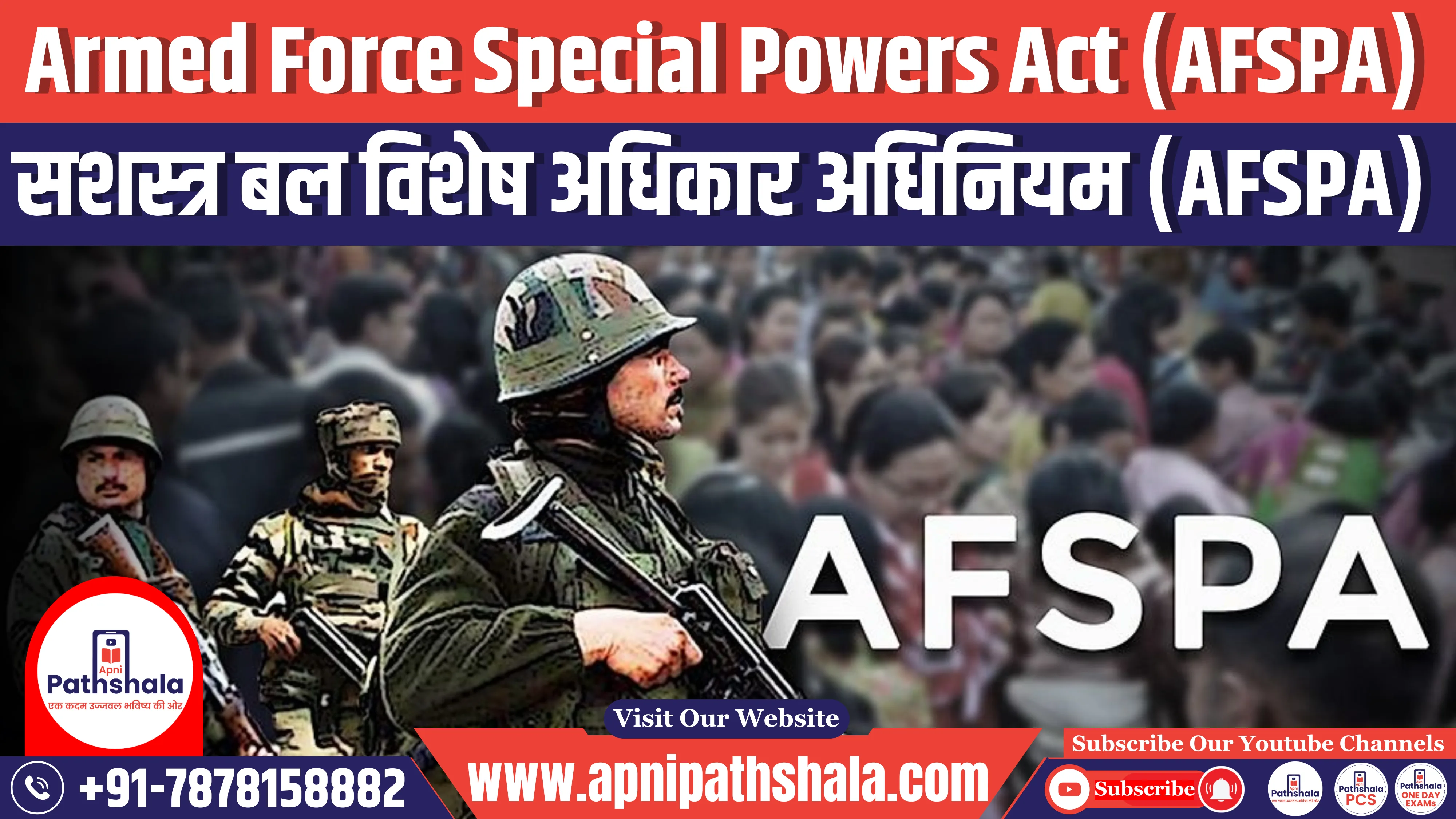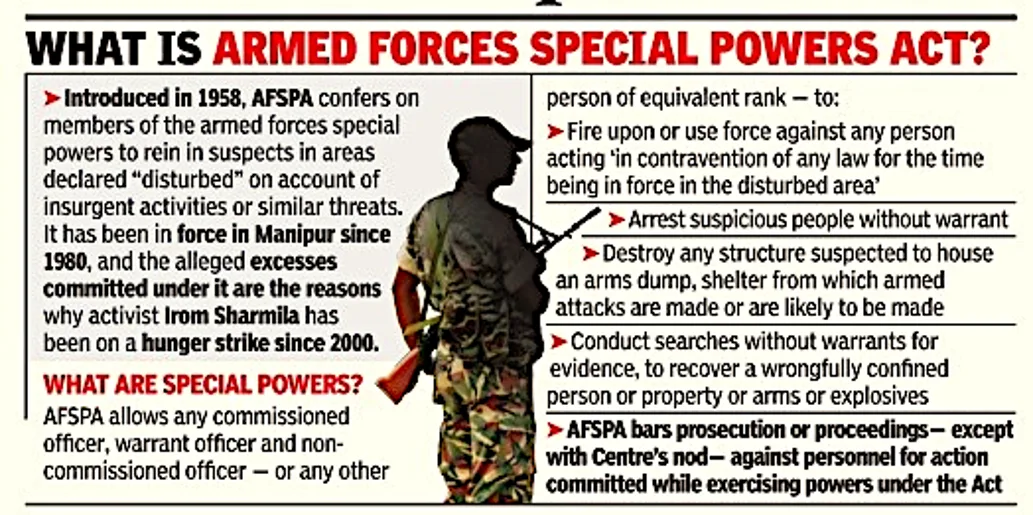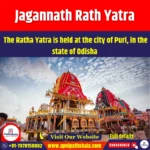What’s in this Article?
- Table of Contents
- Union home minister Amit Shah on Tuesday (26 March) said that the Centre will consider revoking Armed Forces (Special Powers) Act in Jammu and Kashmir.
- In an interview to JK Media Group, the minister added that the government is planning to pull back troops from the Union territory and leave law and order to the Jammu and Kashmir Police alone.
- “We have plans to pull back troops and leave law and order to the Jammu and Kashmir Police alone. Earlier Jammu and Kashmir police were not trusted but today they are leading operations. We will also think of revoking AFSPA,” Shah added.
- “We will also think of revoking AFSPA,” he added while speaking to a local media outlet. He added that AFSPA has been removed in 70 per cent areas in the northeastern states even though it is in force in J-K.
- Thirty Four years (1990) after the Armed Forces Special Powers Act (AFSPA) was implemented in Jammu and Kashmir, the law still remains a bone of contention in the valley.
- AFSPA in Jammu & Kashmir was enacted in Being an emergency law that gives legal cover to the armed forces operating in disturbed areas from prosecution, it has been a matter of debate among the regional parties with Centre time and again clarifying its stand on the ‘controversial’ law.
- When implemented, Centre was of opinion that several parts of the union territory is in such a disturbed and dangerous condition that defence forces must be given special controlling powers.
- It was first implemented when the entire law-and-order situation collapsed in the Valley and normal state law enforcement machinery was found inadequate to tackle the rising graph of armed militancy.
About Armed Forces (Special Powers) Act (AFSPA)?
About
- The AFSPA grants extensive authority to both the armed forces and the Central armed police forces stationed in “disturbed areas” to eliminate individuals who are in violation of the law, as well as to detain and search any location without needing a warrant, all while being shielded from prosecution and lawsuits.
- The legislation was initially implemented in 1958 to address the Naga rebellion. It underwent modification in 1972, granting both the Central government and the States the authority to designate an area as “disturbed.”
- Armed forces – According to the act, armed forces refer to military and air forces in operation, encompassing any other Union armed forces in operation.
- Disturbed area – Regions are deemed disturbed due to conflicts among members of various religious, racial, linguistic, regional, caste, or communal groups. These areas are temporarily designated as disturbed areas through notifications issued under section 3 of the AFSPA Act.
Historical background
- Pre-Independence
- The AFSPA, akin to several other contentious laws, traces its origins back to colonial times.
- Initially introduced as an ordinance in response to the upheaval of the Quit India Movement led by Mahatma Gandhi in 1942, it emerged amidst widespread violence following the movement’s launch. With prominent leaders like Mahatma Gandhi, Jawaharlal Nehru, and VB Patel detained, and unrest escalating nationwide, Viceroy Linlithgow enacted the Armed Forces (Special Powers) Ordinance,
- This decree essentially granted the Armed Forces considerable authority, including the discretion to use lethal force during internal disturbances.
- Modeled after this ordinance, the Indian government issued four similar decrees in 1947 to address security challenges and unrest stemming from the partition in Bengal, Assam, East Bengal, and the United Provinces.
- Post-Independence
- The Indian Parliament has enacted three different acts under AFSPA for different regions
1. Armed Forces Special Powers (Assam and Manipur) Act, 1958
- AFSPA was initially instituted to address the Naga insurgency in the Assam region.
- In 1951, the Naga National Council (NNC) held a plebiscite where approximately 99 percent of Nagas voted for an independent Naga nation. This led to a boycott of the 1952 general election, which expanded to include government institutions and officials.
- To confront the escalating situation, the Assam government implemented the Assam Maintenance of Public Order (Autonomous District) Act in the Naga Hills in 1953 and intensified police operations against the insurgents.
- However, as the rebellion persisted, the Assam government deployed the Assam Rifles in the Naga Hills and enacted the Assam Disturbed Areas Act of 1955, providing a legal basis for paramilitary and state police forces to counter the insurgency.
- Despite these measures, the Naga rebellion persisted, leading to the establishment of a parallel government by the rebel Naga Nationalist Council (NNC) in
- In response to this escalating threat, President Dr. Rajendra Prasad promulgated the Armed Forces (Assam and Manipur) Special Powers Ordinance in May 1958, which was later replaced by the Armed Forces (Assam and Manipur) Special Powers Act of
- This act authorized only the Governors of the States and the Administrators of the Union Territories to designate areas within their respective jurisdictions as ‘disturbed’.
- The rationale for granting such authority, as stated in the “Objects and Reasons” included in the Bill, was to align with the duty of the Union under Article 355 of the Indian Constitution to safeguard every State against internal disturbances.
- Consequently, it was deemed necessary for the Central government to possess the power to declare areas as ‘disturbed’, thereby enabling its armed forces to exercise special powers.
- Subsequently, this act was extended to cover all North-Eastern states.
2. The Armed Forces (Punjab and Chandigarh) Special Powers Act, 1983
- In 1983, the central government replaced the Armed Forces (Punjab and Chandigarh) Special Powers Ordinance of 1983 with the Armed Forces (Punjab and Chandigarh) Special Powers Act to authorize the central armed forces to operate in Punjab and the union territory of Chandigarh, which were grappling with the Khalistan movement during the 1980s.
- The Act was implemented throughout Punjab and Chandigarh in 1983. Its provisions closely mirrored those of the Armed Forces Special Powers Act (Assam and Manipur) of 1972, with two additional sections granting enhanced powers to the armed forces.
- Sub-section (e) of Section 4 empowered the forces to stop, search, and seize vehicles suspected of carrying proclaimed offenders or ammunition.
- Section 5 granted soldiers the authority to forcibly break open locks if the key was withheld.
- Following the decline of the Khalistan movement, AFSPA was withdrawn in 1997, about 14 years after its enactment.
- Although the Punjab government repealed its Disturbed Areas Act in 2008, AFSPA persisted in Chandigarh until September 2012, when the Punjab and Haryana High Court invalidated it.
3. The Armed Forces (Jammu and Kashmir) Special Powers Act, 1990
- The AFSPA was introduced in Jammu & Kashmir in 1990 to address the significant increase in militancy and insurgency in the region.
- If either the Governor of Jammu and Kashmir or the Central Government believes that the entire state or any part of it is in a state of disturbance and danger, this legislation can be enforced.
- Although Jammu and Kashmir have their own Disturbed Areas Act (DAA), which was established in 1992, even after its expiration in 1998, the government argued that the state could still be designated as a disturbed area under Section (3) of AFSPA.
- The implementation of AFSPA in J&K has been highly contentious, yet it remains in effect.
Provisions of Armed Force Special Powers Act (AFSPA) –
- The Governor of a State or the Central Government holds the power to designate any part or the entirety of a state as a disturbed area.
- This declaration can be made by the Governor of the state, the Administrator of the Union Territory, or the Central Government, with publication in the official gazette signifying the designation of the land as disturbed.
- Although state governments can suggest whether the Act should be enforced, the Governor or the Center can override this decision as per Section (3) of the legislation.
- Such action may be taken if there’s a perceived necessity to disrupt terrorist activities or any other actions that could endanger India’s sovereignty or show disrespect towards the national symbols or Constitution.
- Under Section (3) of the AFSPA, the Central government is authorized to deploy military forces to aid civilian authorities upon submission of an official announcement by the state’s governor in the Gazette of India.
- As per The Disturbed Areas Act of 1976, once an area is declared “disturbed,” it must remain so for at least three months.
- In accordance with Section (4) of the AFSPA, army officers in troubled areas possess extensive powers to use force, including lethal force, against those suspected of breaking the law (such as gatherings of five or more individuals, carrying weapons, etc.), provided a warning is issued beforehand.
- Security forces can arrest individuals without a warrant and conduct searches without consent.
- Upon arrest, individuals must be brought to the nearest police station promptly.
- Furthermore, prior approval from the Central Government is required before prosecuting an officer on duty for alleged human rights violations.
States under AFSPA Act
- Assam: In 1958, Assam became the first state to enact the AFSPA.
- This was necessary because of the expansion of ULFA’s activity in the region, which peaked in the 1990
- Jammu & kashmir: Since July 5, 1990, the AFSPA has allowed security personnel to conduct operations anywhere and arrest anyone without a warrant.
- After the former state of J&K became a Union Territory, neither the Disturbed Area Act nor the AFSPA were repealed.
- Tripura: The AFSPA was initially implemented in Tripura in 1997, at a time when terrorism was at its apex in the border state, which shares an 856-kilometre border with Bangladesh.
- After 18 years, AFSPA was lifted from Tripura in May 2015 due to a sustained drop in insurgent activity.
- Manipur: Manipur was declared as a ‘disturbed area’ for the first time in This was done in order to battle four rebel factions active in the state at the time.
- The Army’s major mission in Manipur is counter-insurgency operations. The state borders the Republic of Myanmar, from where various terrorist organisations operate.
- Arunachal pradesh: Three districts and 16 police station boundaries in the state have been designated as ‘disturbed zones’ under Section 3 of the AFSPA.
- In March 2022, the government extended the Armed Forces (Special Powers) Act in three Arunachal Pradesh districts from April 1 to September 30,
- Meghalaya: AFSPA applied to a territory in Meghalaya within a 20-kilometre strip that shared access with the Assam region.
- Due to a decline in insurgency-related occurrences in the state, AFSPA was repealed in Meghalaya on March 31,
- Mizoram: The Mizoram insurgency ended with the signing of the Mizoram Peace Accord in Mizoram has been a peaceful state since then.
- From 1978 to 1979, the AFSPA was not in effect in the state.
- Nagaland: The AFSPA has been in effect in Nagaland for several decades and applies to the whole state.
- The AFSPA will be phased down from April 1, The withdrawal affects around 25% of the state’s overall land area.
Observation of Government Committees Over the AFSPA
- The Jeevan Reddy committee to review AFSPA
Following years of protests against the AFSPA and concerns regarding human rights violations, the committee put forth several recommendations:
- Following consultations with all relevant stakeholders, the committee advised the abolition of AFSPA.
- Instead of AFSPA, a more comprehensive framework should be established under the Unlawful Activities Prevention Act.
- Central forces should be deployed to assist civil authorities.
- Authorization to use force should be granted solely to commissioned officers when deemed necessary.
- It was recommended that each district where these forces are deployed should have an independent and competent grievances cell to investigate rights violations.
- Justice Santosh Hegde Committee: Justice Santosh Hegde Committee to investigate fake encounters in Manipur described it as a “symbol of oppression”.
- Justice Verma Committee Justice: Verma committee (on offenses against women in conflict areas) said “AFSPA legitimizes impunity for sexual violence” E.g. Kunan Poshpora incident; Thangjam Manorama case in Manipur.
- Second ARC Report: The 5th report of the Second Administrative Reforms Commission on public order has also recommended the repeal of the AFSPA.
Role of the judiciary
- There have been debates regarding the constitutionality of the Armed Forces Special Powers Act (AFSPA), particularly because law and order typically falls under the jurisdiction of the states.
- However, the Supreme Court, in its 1998 ruling (Naga People’s Movement of Human Rights v. Union of India), affirmed the constitutionality of AFSPA. The Court’s ruling included several key points:
- The Central government can declare an area as ‘disturbed’ on its own initiative, but it is preferable for the state government to be consulted beforehand.
- AFSPA does not grant arbitrary powers for declaring an area as ‘disturbed.’
- Such declarations must be temporary and subject to review every six months.
- When utilizing the authority granted by AFSPA, authorized officers should use the minimum force necessary.
- These officers must adhere strictly to guidelines provided by the army.
- Recently, the Supreme Court ruled that any death occurring in a disturbed area involving either a civilian or an insurgent must undergo a thorough investigation to determine if it was an extrajudicial killing.
- This implies that armed forces personnel do not have absolute immunity, even in disturbed areas.
- The Supreme Court was addressing a petition requesting an inquiry into 1,528 deaths purportedly resulting from fake or extrajudicial encounters by the armed forces in Manipur.
Criticism of AFSPA
- Criticism of the Armed Forces Special Powers Act (AFSPA) primarily revolves around concerns regarding human rights violations, excessive use of force, lack of accountability, and undermining of democratic principles.
- Human Rights Violations: AFSPA grants broad powers to the armed forces, including the authority to shoot to kill, arrest without a warrant, and conduct searches.
- Critics argue that these powers are prone to abuse and have led to numerous instances of human rights violations, including extrajudicial killings, torture, disappearances, and sexual violence.
- Lack of Accountability: One of the main criticisms is the lack of accountability mechanisms for security personnel operating under AFSPA.
- The Act provides immunity from prosecution unless the central government grants permission to prosecute. This has resulted in a culture of impunity, where security forces can commit abuses without fear of consequences.
- Undermining Democratic Principles: AFSPA is often seen as undermining democratic principles by vesting excessive powers in the military and undermining civilian authority.
- Critics argue that the Act erodes the rule of law and democratic governance by allowing the military to override civilian institutions and legal processes.
- Impact on Civilian Population: The presence of security forces empowered by AFSPA can create an atmosphere of fear and intimidation among civilian populations, leading to a breakdown of trust between the state and its citizens.
- The Act’s provisions, such as the power to declare areas as “disturbed” and impose curfews, can disrupt civilian life and livelihoods.
- Failure to Address Root Causes: Critics argue that AFSPA addresses symptoms rather than root causes of conflict and insurgency.
- Instead of addressing grievances and underlying socio-political issues, the Act relies on a militarized approach that can exacerbate tensions and alienate local populations.
- International Criticism: AFSPA has also faced criticism from international human rights organizations and bodies, such as the United Nations, for its alleged violations of international humanitarian law and human rights standards.
- Overall, the criticism of AFSPA centers on its impact on human rights, democracy, civilian-military relations, and its failure to address the underlying causes of conflict.
- Critics advocate for the repeal or significant reform of the Act to ensure the protection of human rights and the rule of law in conflict-affected regions.
AFSPA: Way Forward / Recommendations
- The current state of the act is no longer deemed acceptable due to numerous instances of human rights violations that have occurred over time.
- AFSPA has evolved into a symbol of oppression in the regions where it has been enforced.
- Therefore, it is imperative for the government to acknowledge the grievances of affected individuals and provide assurances of remedial measures.
- The government ought to assess the imposition and removal of AFSPA on a case-by-case basis, restricting its application to specific troubled districts rather than implementing it across entire states.
- Additionally, both the government and security forces must adhere to the guidelines outlined by the Supreme Court, the Jeevan Reddy Commission, and the National Human Rights Commission (NHRC).
Recommendations for the Betterment of the AFSPA Act
- Case-specific Application: Implement AFSPA selectively, based on the severity of the situation in particular areas rather than applying it uniformly across entire states. This targeted approach can minimize the negative impact on civilians while still allowing security forces to address specific threats effectively.
- Human Rights Oversight: Establish a robust system for monitoring and ensuring compliance with human rights standards by government and security forces operating under AFSPA. This could involve regular reporting, independent investigations of alleged violations, and accountability mechanisms for those found responsible.
- Legal Reforms: Review and update the legal framework of AFSPA to align it more closely with international human rights norms and principles. This may include clarifying the scope of powers granted to security forces, specifying conditions for the imposition and lifting of AFSPA, and incorporating safeguards to prevent abuse.
- Civilian Engagement: Involve local communities and civil society organizations in decision-making processes related to AFSPA. This can help build trust, enhance transparency, and ensure that the concerns and perspectives of affected populations are taken into account.
- Training and Sensitization: Provide comprehensive training to security personnel deployed under AFSPA on human rights law, rules of engagement, and the importance of respecting civilian rights and dignity. Sensitization programs can help foster a culture of accountability and responsibility among personnel.
- Conflict Resolution and Peacebuilding: Address underlying grievances and root causes of conflict through political dialogue, development initiatives, and efforts to promote reconciliation. Sustainable peace and stability are essential for reducing the need for extraor dinary security measures like AFSPA.
- Regular Review and Evaluation: Conduct periodic assessments of the effectiveness, necessity, and impact of AFSPA, with input from various stakeholders including affected communities, human rights experts, and security officials. This ongoing evaluation can inform adjustments and improvements to the implementation of the act over time.
- The government and the security forces have to abide by the guidelines set out by – The Supreme Court, Jeevan Reddy Commission, Santosh Hegde Committee and the NHRC.
Conclusion
- While judicial efforts have significantly advanced accountability in conflict areas and emphasized fundamental democratic and human rights, their impact is constrained by persistent governmental and military attitudes aimed at preserving the existing state of affairs.
- The continuous occurrence of human rights abuses renders the current status quo untenable. In areas where it’s enforced, AFSPA symbolizes oppression.
- Thus, the government must acknowledge the plight of affected individuals and commit to taking constructive steps. Considering the context, a nuanced approach of selectively implementing or rescinding AFSPA, tailored to specific troubled regions rather than blanket application across entire states, warrants exploration.
Disclaimer: The article may contain information pertaining to prior academic years; for further information, visit the exam’s “official or concerned website“.
Frequently Asked Questions (FAQ’s)
1. What is AFSPA act?
Armed Force Special Powers Act 1958 ( AFSPA ), empowers the army, state and police forces to shoot to kill, search homes, and demolish any property that is “likely” to be utilized by insurgents in regions designated by the home ministry as “disturbed.”
2. What is the meaning of Disturbed area in AFSPA Act?
According to Section 3 of the AFSPA, The Governor of the state, the Administrator of the Union Territory, or the Central Government can proclaim a region to be a “disturbed area.” By publishing a notice in the official gazette, the entire land or a portion of it can be deemed disturbed.
3. What is disturbed areas (AFSPA)?
A disturbed area is one that has been declared by notice under Section 3 of the AFSPA. Disagreements or disagreements between members of various religious, ethnic, linguistic, or regional groups, castes, or communities can cause havoc in a community. The Central Government, the Governor of the State, or the Administrator of the Union Territory may declare the entire or a portion of the State or Union Territory to be a disturbed region.
Q. 1 Consider the following statements
1. Only the centre has the authority to declare a specific area as a disturbed area under the AFSPA.
2. The government’s decision to declare a specific region “disturbed” cannot be contested in court.
Which of the following statements is/are correct?
(a) 1 only
(b) 2 only
(c) Both 1 and 2
(d) Neither 1 nor 2
Ans: b
Q. 2 Who among the following has the authority to declare AFSPA in a disturbed area?
1. Judiciary (Supreme Court and High Courts only).
2. State Governments
3. Central Government
Choose the correct code from below
(a) 1 and 3
(b) 3 only
(c) 2 and 3
(d) All of the above.
Ans: c
Explore our courses: https://apnipathshala.com/courses/
Explore Our test Series: https://tests.apnipathshala.com/










